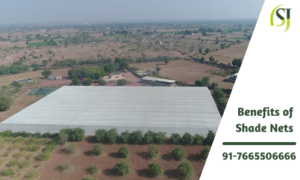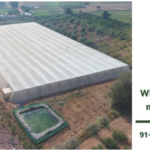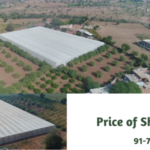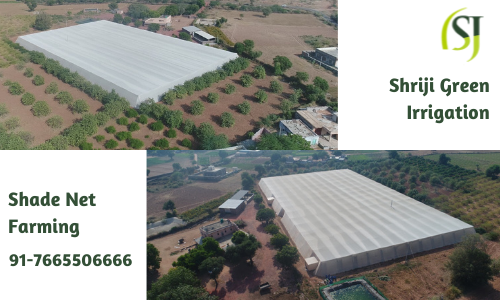Anyone who has grown their own vegetables must use Shade Net as he knows that there are many pests out there that can destroy your crops before you ever get to taste them. From birds and squirrels to insects and rodents.
Your garden may be protected with many different types of netting and cages. But these methods will not always work.
That’s why it’s important to know about the latest products on the market. Such as the High Durability and Flexible Garden Agro Shade Net! This unique product protects your plants from any size bird or animal. Allowing you to enjoy fresh veggies all year long!
There are many benefits to using a Green net for garden in your garden. To protect your produce from the hot sun and other threats like animals and insects.
The best type of netting you can use depends on. Your needs and what your objectives are with your garden.
This article will provide insight into the different types of Agro Shade Net available. And which one would be most beneficial to you. Depending on what you’re trying to protect. And how long you want the protection to last.
Table of Contents
What are Shade Nets?
Shade nets are protective nets that is installed over plants, shrubs, and other parts of a garden. To block damaging sun rays while allowing light through. Shade nets are used in orchards. Where they’re known as fruit tree shade nets.
They’re also sometimes used in vegetable gardens. Additionally, you may see them referred to as plant shade nets or nursery shade nets. Depending on what sort of plantings you intend to place them over.
These materials come in either woven polyethylene fibre or knitted mesh styles. But regardless of style both provide UV protection and can last for many years if properly cared for.
Why Do We Need These Types of Shade net house?
There are so many reasons why shade netting is an important tool in any gardener’s arsenal.
- It provides protection for plants.
- Shade Nets can also be used to cover lawn furniture or outdoor dining areas.
- Shade netting will block out harmful ultraviolet rays.
- Keeps plants hydrated and protected from pests.
- It’s especially useful during warmer months when direct sunlight could hurt certain crops, like potatoes.
- If you live in a hot climate that sees plenty of sunlight throughout much of the year. Then shade netting might just be what you need!
Also if you want to keep animals out of your garden. You may want to check out our pet-friendly products as well! The versatility of our durable polyethylene mesh. Makes it one of our most popular product lines. Available on today’s market.
How Are These Green Nets Made?
The vegetable mesh can be made from durable polypropylene yarn. That is UV resistant, even in direct sunlight. The textile that forms these nets can then be knitted or woven. Into a variety of patterns that will help support a wide range of produce.
These nets can be designed as a flat-screen. A tubular canopy over rows of plants, or other types of configurations. A single person can install them quickly and easily.
You don’t need professional equipment or tools. Just some basic supplies like scissors and zip ties! And because you are controlling every element of the process. You have full control over what kind of design you want. Imagine having an organic fence for your garden! It’s easy with any of our designs!

List of Benefits of Shade Net
Shade netting works as a great way of protecting crops from weather conditions. Durable, flexible and highly effective it is highly recommended. That you choose a high-quality product. If you want to keep your crops flourishing through good times and bad.
Here are some of shade net’s top-selling points
-
Weather Protection:
Shade nets work as a protective barrier between sensitive crops and inclement weather. In hot countries where temperatures regularly climb above 100 degrees Fahrenheit (38 Celsius). Shade netting can prevent excessive heat from harming your plants. In more temperate climes, shade nets can be used to guard. Against frosts or heavy rains. helping guard against crop loss on a cold night or a sudden shower on a day when the sun is forecasted.
-
Stays Tight Over Time:
The biggest downfall with many net materials is their propensity to sag with age. This isn’t a problem for shade nets, however- these nets were specifically designed to stay tight throughout their lifespan, allowing them to remain an effective barrier even after years of exposure.
-
Lightweight & Flexible:
Being less dense than other materials such as plastic or metal shade nets are easily moved without special equipment – a valuable property for any farmer who wants to stop pests before they do damage. At two pounds per square yard (1 kilogram per square meter), standard shade netting is also much lighter than its rivals, giving it major advantages over glass or polyethylene alternatives in terms of cost-effectiveness.
-
Conforms to Different Surfaces:
Because all agricultural shade nets are made by hand there’s significant variation in the final size. Perfect for farmers seeking bespoke solutions. That conform exactly to their land shapes and sizes.
Net Advantage Inc. sells durable shade net at affordable prices while meeting international standards. Our premium gardening kits come complete. With everything, you need to start growing today including tools, seeds and fertilizers.
At Shriji Green Irrigation, we guarantee our products will last for several seasons. Unlike cheap imitations found elsewhere in shopping centres. Which often tear under pressure in weeks rather than months.
Different types of Shade Net For your Polyhouse
Although every gardener has a different set of goals and needs, shade cloth, or mesh screen. These can help increase yields and encourage early plantings. For those with greenhouses or hoop houses, a shade net can also be used as a wind barrier.
There are several different types of shade net made for gardening uses such as
- Polypropylene
- UV-resistant nylon.
Shade netting comes in a variety of sizes and mesh-size specifications. The type of net house you choose for your polyhouse. Should be large enough to hold up against strong winds. Without becoming so large that it flies away.
Mesh size refers to how much light passes through each square inch of mesh. And manufacturers typically use mesh sizes such as 30 x 30 or 50 x 50 inches for their nets.
If you’re growing leafy vegetables, look for shade netting with smaller mesh holes. If you’re growing delicate flowers, look for larger openings. Other considerations include ultraviolet (UV) resistance—
- Are your plants prone to damage from UV rays?
- Do they need extra protection from insects or birds?
Think about these things when choosing your shade net.
Like other types of shade netting,
Polypropylene:
This is an economical choice for protecting plants. From the hot sun and pests like birds and bugs. Netting made out of other materials. Such as PVC or vinyl will stretch easily. But won’t last as long as those made out of nylon. Those made out of cotton tend to shrink over time.
Polyethylene shade nets are highly durable, flexible, and resistant to water damage. They can also withstand high winds without snapping into pieces. Or causing damages to nearby crops.
However, not all kinds of polyethylene are equal. Pay attention to thread count when making your purchase. if it isn’t thick enough, you risk having penetrations on your sheeting surface!
UV resistance:
If sunlight will hit your clothes frequently. Make sure your canopy fabrics offer proper filtering to protect your plants.
What is a shade net house?

Shade net houses are a great way of growing plants in partial shade. When placed over a section of a garden, they can be used to grow a wide variety of plants undercover while still getting some light from above. They work particularly well in areas that get hot and sunny during part of the day but then cool off at night, or where there are more hours of sunshine than ideal for good plant growth. Shade nets are available in several different styles depending on their main purpose, although most are flat sheets held up by ropes. Some have longer sides to make larger structures with higher walls to protect both climbers and ground-level vegetables. HDPE Nylon nets last much longer than polyester ones when exposed to sunlight because nylon fades more slowly; nylon also allows air through better so lessens the risk of rot due to humidity buildup inside a structure. Nylon is stronger than polyester so lasts longer if strained repeatedly against the weight of crops.
How to construct a Shade net house Structure?
Shade net houses, also known as high tunnels and hoop houses, offer many benefits for anyone who wants their produce and flowers grown in an environmentally sustainable way. A shade house allows gardeners to provide just enough warmth and sunlight to their plants so that they can grow quickly. The shelter of these structures helps keep wind and rain at bay, which means more consistent soil temperatures throughout the day. However, there are several different types of net available for purchase depending on what type of structure you intend to build. Here are some details about each kind: Screening Net : Also referred to as mesh screen or gauze mesh. The largest openings allow airflow while keeping insects out. Can be used with greenhouses or stand-alone hoops. Relatively inexpensive compared to other options. Easy to cut using simple household scissors.
How to build a Shade net house design?
Setting up a shade net house for your garden will help you grow healthy produce even in direct sunlight. All you need are some sturdy cables, tensioners and shade nets. Here’s how you can build a DIY shade net house in an afternoon. If you have access to inexpensive roll-down shades at home (like those used as window coverings), they’re all set. However, if not, here are things you might like to consider: Net Sizes - If your outdoor space is big enough for a larger structure, go ahead and make it bigger; don't worry about durability—gardens tend to last longer than houses! You could always scale down later as and when required. Also, be mindful of local codes for net size (especially if you live close to residential areas). Use cotton or other natural fibers instead of synthetic ones like nylon or polyester because these may catch fire easily. It's also safer for kids who may play under or around these structures. The Easy Way Out - On Amazon, look for readymade kits that come with netting (usually between 5x5m & 7x7m). They're easy to assemble and pretty durable too.
Which shade net is best?

There are a variety of different shade nets on the market, so choosing one isn’t as easy as it sounds. It’s very important that you choose a green net that is UV stabilized and flame retardant because these qualities ensure that your investment will hold up over time. In addition, you should also look for a shade net that is resistant to rotting and moulding because those materials can degrade easily in damp conditions. Also, remember that colour fades if your shade net becomes wet or dry frequently. If you want something other than black there are some options available, but understand that colours might fade after a few years due to sun exposure. As mentioned previously nylon stretches more than polyester which makes it ideal for forming into shapes that match plants rather than laying flat.
What is the use of a shading net?
If you have a sun or UV-loving plant in your backyard, one of our shade nets will help you grow it better. While they are most commonly used in greenhouses, they’re also great for containers or any place you want to give plants some protection from wind, hail, cold weather or excessive heat. Shade nets are easy to install and are available in different sizes and materials for different applications. We make all of our shade nets out of high-quality polyethylene fibre with UV inhibitors.
What is the green shade net price?
The price of a green shade net starts from as low as $3.50 per sqft and can be a lot more expensive depending on a number of factors, including size and demand. To find out how much it would cost to cover your particular space, talk with a specialist or read reviews from other buyers who’ve already used shade net for their own purposes. It’s important to make sure you buy an eco-friendly product because by doing so you can ensure that it will last longer and help keep pests at bay in future seasons. Other important things include making sure the color won’t fade over time or change when exposed to sunlight; also check if there are any holes when you open up each roll.
Best Shade Net Manufactures
The great thing about shade nets, also known as anti-UV nets, is that they are so versatile. You can use them in any industry or field where UV rays are harmful. For example, if you want to plant trees in an area that will need protection from direct sunlight for years until they grow strong enough to tolerate it, then shade nets would be a good investment. If you own a vineyard and don’t want to risk losing any precious grapes due to sun exposure, then protective shade nets could do away with all of those concerns. I have even heard of people using them around swimming pools!
What is the Shade Net price per Kg?

The price range is from Rs. 100/- per kg. Our product Shades-Net® is a lightweight and flexible Polypropylene mesh with Sun protection factor of more than 50%. It can be rolled up for transport and re-use, lasts up to five years in normal conditions, protects from the wind as well as from hailstones etc. It works as a heat reflector as well as a dust filter. The shade factor increases with its thickness or density which goes up to 80% or more.
Where is a Low-cost shade net house design available?
Many farmers prefer growing their vegetables in greenhouses because they’re less expensive and more accessible than land for farming. The main disadvantage of glass greenhouses, however, is that they require a lot of water and sunlight. Therefore, Shriji Green has come up with a new model—the lowest-cost shade net house design available, to help farmers grow their crops easily and sustainably year-round without needing excessive amounts of sunlight or water.
What is the Material of Net House?
Net houses are made from nylon and polyester; both of which are highly durable and flexible. A wide variety of colors and styles are available on our website, so you can choose a design that’s ideal for you. Additionally, we provide several customization options: you can add grommets and corners, remove them entirely or add them elsewhere (if necessary), purchase fully-lined models, etc. Whatever option fits your needs, we have it! Each model is UV resistant and rot-proof. Each model is UV resistant and rot-proof. We take pride in what we do, which is why each one comes with a lifetime guarantee against breakage. When an installation company tells you they can put up nets for your gardening project for next week—that shouldn’t be cause for alarm.
How to do Net House Farming?
When you’re using a manual garden, it’s important to protect your plants from harmful bugs and insects that can cause damage or destruction. Many people choose to build structures around their gardens that will act as miniature greenhouses. One of these structures, called a hoop house, is easy to create with inexpensive materials and can be placed over almost any size of the crop at any stage in its growth cycle.
What is Agro Shade Net Farming?
Agro shade netting is a lightweight, highly durable and flexible multi-use product for farmers of all types. Using it can save farmers time and money by protecting their crops, fruits, vegetables and flowers from pests, bad weather and diseases. While also allowing for maximum exposure to sunlight. Learn more about Agro Shade Net Farming today!

